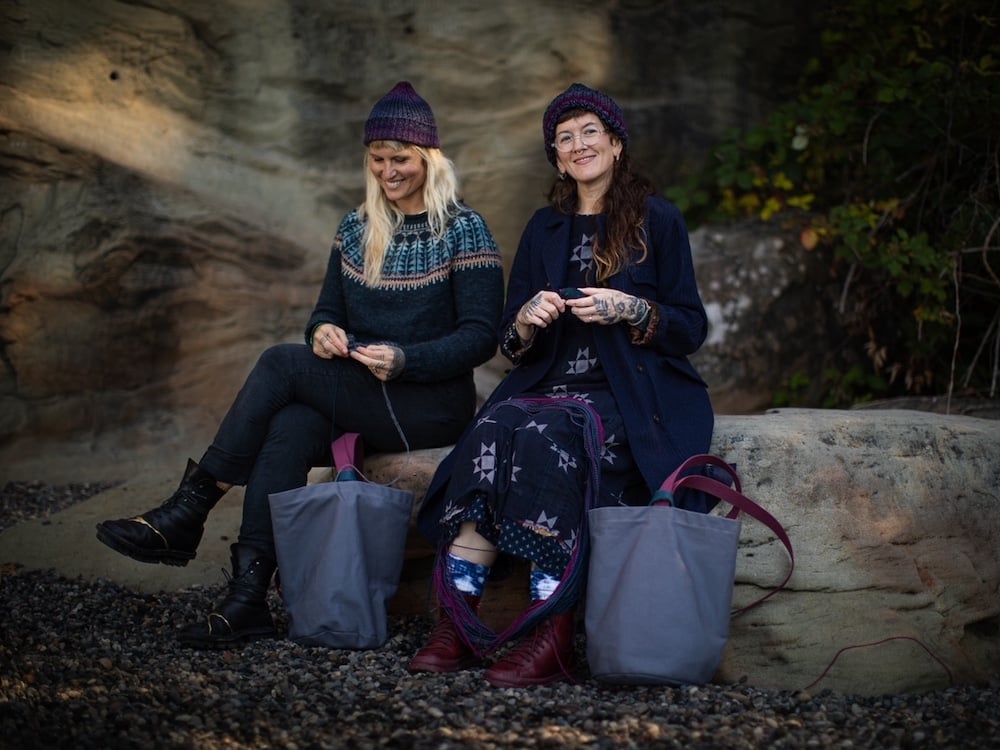WHY SPINCYCLE YARNS WORKS Who works: Twenty-eight people work at Spincycle Yarns. That includes owners Rachel Price and Kate Burge, as well as those who work in the retail storefront, the mill, the dye house and the administrative offices. What works: Spincycle has effectively scaled its eco-conscious business from small-scale to mid-scale, retaining its labour-friendly values.
What works for the bioregion: Spincycle sources its wool from the United States and takes a zero-waste approach to its yarn. With plans to renovate a building in downtown Bellingham, its operations will soon be housed under one roof, reducing its carbon footprint. For nearly a decade, the Spinsters were a fixture at the Bellingham Farmers Market.

Their booth was easy to find: market goers just needed to look for their brightly coloured yarns in vibrant cyan and deep magenta. Founders Kate Burge and Rachel Price commuted to the market by bike — neither one owned a car at the time — and set up most Saturdays. The duo, who named their company Spincycle, specialized in a type of craft practised by few others in the early 2000s: kettle-dyeing and hand-spinning wool into beautiful skeins.
Unlike most commercial yarns, which are spun and then dyed, the yarn Burge and Price create is dyed first, before it’s spun into yarn. “The hues sunset into one another and where the surprise tones that occur when one colour blends with another is as unique from skein to skein as a fingerprint,” the company says. The resulting yarn carries names like Absolute Zero (deep pinks and purples with just a hint of light blue), Bright Idea (bright blues with hot reds and oranges) and Fluorite (eye-watering pinks, blues and yellows in highlighter-appropriate shades).
Spincycle’s colourful, unique yarns. Photo supplied. At first, Burge and Price did everything by hand.
But soon enough, the tattooed twosome had developed a big enough following that they’d outgrown dyeing in their apartment kitchens. They sought studio space to get out of their roommates’ hair. Twenty years later, Spincycle’s success tells a different story: small-scale manufacturing can return to North America, helping bring life back to hollowed-out downtown cores — and reviving near-lost arts like wool milling.
Increasing production Textile manufacturing used to be a force in the United States. Price’s father worked at a blue jean factory in Mississippi. Everything was local.
Cotton picked from local fields was processed and made into jeans all in one facility. But it was also expensive. When companies discovered they could move production overseas for cheap, they did.
Price recalls her father showing up to work one day only to find the factory shuttered. The trend continued across the country. While cotton mills used to number more than 900 in the late 1800s, Bloomberg recently reported , today, there are just 100 cotton plants left.
In Bellingham, empty buildings in the downtown core — souvenirs from the Depression — were transformed into factories during the Second World War. As cars became popular in the postwar era, architecture was removed to make way for more auto-centric urban planning. By the late 1980s, many businesses had left downtown to set up shop at the Bellis Fair mall.
Burge and Price’s planned relocation aligns with recent revitalization efforts — Bellingham’s downtown core now plays host to a weekly farmers market and has become more of a mixed-use neighbourhood. Spincycle’s successes also fold well into a different, textile-related trend. The rise of fast fashion from labels like Shein and Zara has seen a corresponding shift back to handmade goods, crafted slowly and locally.
Customers, aware of the labour and environmental costs of fast fashion, began to seek out alternatives. Well-loved bottles of dye in many different shades sit at the ready at Spincycle Yarns’ warehouse in Bellingham, Washington. Photo supplied.
By the early 2010s, Spincycle had built a reliable customer base for their colourful yarn. But they’d begun to push up against the boundaries of their operation. Their two-ply sock yarn, for example — essentially, two strands of yarn twisted together to create a single strand — was gorgeous, but overly laborious to make.
It was “prohibitively expensive,” says Price. “Even with inflation, the prices we had set on our sock yarn back then would be crazy today. We were like, ‘How do we get paid minimum wage, by the hour? Well, here’s this $80 skein of sock yarn.
’” Because Spincycle was working in such small batches, designers were also reluctant to create patterns for their yarns, for fear there wouldn’t be enough available to keep up with potential demand. RELATED STORIES Shear Genius: Turning Waste Wool into Clean Fertilizer And designers are important: knitters don’t just whip out a ball of yarn and start knitting without a plan. Most will follow a pattern, which is like a recipe for your project; it tells you what type of yarn you need, how much and what techniques are required to finish your project.
So Spincycle had hit its tipping point. If Burge and Price wanted to continue, they needed to find a way to scale up their business. Around 2010, a chance meeting created new opportunities for the Spinsters.
They connected with a family opening up a mill nearby. Burge and Price had dreamt up a way to make their sock yarn more economical, with the help of machines, while still honouring its hand-dyed look. Most established mills had clients and waiting lists, but Spincycle was able to get in on the ground floor with the new mill.
The plan worked; they were able to produce a slow colour-changing sock yarn without the cost of making it by hand. Production increased steeply. But Spincycle was still a small operation, with just Price and Burge working full time, assisted by a handful of part-timers who tagged and twisted yarn and handled shipping.
Seven years later, when the mill was set to close, Burge and Price put together an offer for the equipment. They secured a lease and a loan and moved it into a warehouse in an industrial part of Bellingham near the highway, where it’s still based today. Jasmine Escalante works at the spin frame, which twists wool fibre into yarn.
Photo supplied. Luckily for the Spinsters, Anna Kalahan, the former mill’s sole employee, was up for the move. The machinery, which was ancient, had never come with a manual.
Instead, its manufacturer had installed it and taught the owner how to use it; in turn, they’d taught other operators. “The actual running of the milling equipment is not difficult,” Kalahan told a local publication. “It just takes some time and repetition to become nimble at the hands-on tasks with the fibre and at the equipment.
” The toughest thing, Kalahan said, was running everything simultaneously and noticing problems “before they turn into giant, messy piles and knots of fibre.” Rebuilding local knowledge Since Spincycle founded their mill in 2017, they’ve added over 20 employees to their operation. Each new hire for the production side of the company is extensively trained to pass on the institutional knowledge about the workings of the mill.
It takes around three months for a new hire to get up to speed, and longer still to integrate with the rest of the team — the production floor is a deafening environment and non-verbal communication is key. From the company’s modest beginnings in the early 2000s, they’ve grown steadily. They now process up to 10 tonnes of wool a year, says Price.
Key to their success is fostering an environment that is fun and fair for employees. Spincycle pays a living wage and offers health-care plans and paid time off. “We just really want to have a happy workplace,” Price says.
Timmothy Welch works at a pin drafter in the warehouse. It’s one of the last steps in a long mill process. Photo supplied.
In 2018, popular knitwear designer Andrea Mowry released a cowl pattern using a Spincycle yarn called Dyed in the Wool. They had to hire extra help to keep up with demand. Working with designers has been good for business.
Price says it’s also helped them see different ways to use their yarn. Mowry’s vision for the cowl, for example, combined a kaleidoscope of colours from three different skeins. “We were like, ‘It can’t be done.
That’s crazy,’” Price says. “Andrea saw something that we didn’t even see.” A few months later, Mowry released a second pattern, this time using six different colourways of Spincycle Yarns.
Mowry’s reach (her Instagram account has 230,000 followers today) meant even more orders for the Spinsters. They hired even more help and got a second spin frame, which twists the fibre into yarn, to try to keep up with production. Reducing waste As production ramped up, the small volume of waste created by the yarn-making processes increased as well.
Waste accumulates mostly at the spinning frame stage, when little fibre doughnuts the mill workers call “wraps” form on the spindles. Prior to the scale-up, the wraps were pulled off, then carded together when there was enough material. But now there wasn’t enough downtime and the wraps started to pile up.
Workers organized them in bags by colour. The Spinsters then worked with a neighbouring mill to efficiently blend that waste fibre with merino wool to create a zero-waste yarn called Metamorphic . The biggest challenge, says Price, is making colourways that aren’t muddy.
If you’ve ever tried mixing colours with a paint set, you know how hard it can be to get something other than brown. Bringing operations under one roof Spincycle sources its yarn from neighbouring states. Before it hits the wool mill, it gets sent to South Carolina, where it’s scoured and combed.
“There are some miles on it [the fleece] before it reaches us,” says Price. “But it’s better for the environment than if it had to travel overseas.” Alison Monk works at a machine called the skeiner.
It’s one of the last steps the bundles of yarn go through and organizes the mass of thread into a clean skein. Photo supplied. As it has grown, Spincycle’s operations have expanded to match.
Their mill and dye house are still located in their original warehouse from 2017, while the retail shop calls downtown home, sharing a red brick building with a stationery store. As they look to make their business more eco-friendly and economically efficient, there are plenty of things Price says they want to address. Over at the industrial warehouse that holds the dye pots and mill equipment, for example, the HVAC unit could be better to keep dust down, and green energy could power the machines, reducing the carbon footprint.
To help accomplish their green goals, Spincycle is planning to bring its business under one roof. In 2022, they purchased a roomy building a few doors down from the retail shop in downtown Bellingham and just across the street from the children’s museum. Plans for the extensive renovations they’ll need to undertake have already been drawn up.
The building is vacant and a shade of Band-Aid beige, says Price. They’ll be adding more windows and installing solar power. It’s like coming home, says Price.
The Spinsters had a small studio downtown before acquiring the mill equipment and expanding the business, plus they were a regular fixture at the Bellingham Farmers Market downtown. Burge and Price had also noticed an economic depression hit downtown right after the peak of the COVID pandemic, with many storefronts emptied out. “It felt like we could make a little difference, maybe brighten up a small corner in the heart of Bellingham, so we went for it,” says Price.
Shear Genius: Turning Waste Wool into Clean Fertilizer read more The Spinsters hope to both beautify the downtown core and bring wool manufacturing back to Bellingham. They’re not the only ones looking forward to the transformation. Downtown Bellingham Partnership’s Jenny Hagemann says Spincycle’s move is “an exciting chapter” in the neighbourhood’s “continued revitalization.
” “They will be transforming an underutilized space into a business model reflective of successful Main Street America principles, where they will both produce and sell goods, making it a full economy of employment and consumer benefit,” Hagemann says. Main Street America is a U.S.
organization that supports the revitalization of downtown cores across the country. Now, Burge and Price are just waiting on permits from the city. It’s a complicated building rehabilitation that was estimated at $1.
75 million in 2023. And, of course, they need to choose a new colour for their new building — a tough choice to make, says Price. Perhaps they’ll go for a rainbow sunset of shades, mimicking the beauty of their yarns.
Read more: Labour + Industry.



















